

July 22th, 2014. Possible, Plausible and Probable: Big markets and Networking effects. I do not know Bill Gurley personally, but I do know of him, and I was surprised, sitting in Vienna airport waiting for a connection home on Friday morning, to get an email from him.

In the email, he graciously gave me a heads-up that he was planning to post a counter to my Uber valuation and that it would not pull punches. A little while later, I started getting messages from those who had read the post, with some seeking my response and some seeming to view this as the first volley in some valuation battle. I read the post a few minutes later and the first person I wrote to after I read it was Bill Gurley and I told him that I absolutely loved his post, even though it was at complete odds with my assessment of the company, for two reasons.Like anyone else, I like being right, but I am far more interested in understanding Uber's valuation, and the post provided the vantage point of someone who not only is invested in the company but knows far more about it than I do.
Dueling Narratives. It's Time to Split Up Microsoft. To understand why so many serious Microsoft observers were encouraged by Satya Nadella’s week-ago memo Bold Ambition and Our Core,1 it’s useful to go back 10 years and read Steve Ballmer’s 2004 memo Our Path Forward.
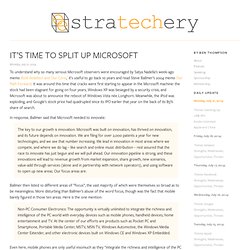
It was around this time that cracks were first starting to appear in the Microsoft machine: the stock had been stagnant for going on four years, Windows XP was besieged by a security crisis, and Microsoft was about to announce the reboot of Windows Vista née Longhorn. Meanwhile, the iPod was exploding, and Google’s stock price had quadrupled since its IPO earlier that year on the back of its 85% share of search. In response, Ballmer said that Microsoft needed to innovate: The key to our growth is innovation. Microsoft was built on innovation, has thrived on innovation, and its future depends on innovation. Ballmer then listed 10 different areas of “focus”, the vast majority of which were themselves so broad as to be meaningless. Recurring Revenue is Magic. In 1998, Yom Kippur fell on September 30th.
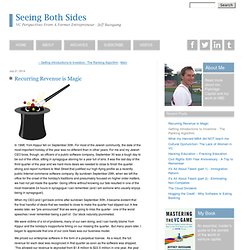
For most of the Jewish community, the date of the most important holiday of the year was no different than in other years. For me and my Jewish CEO boss, though, as officers of a public software company, September 30 was a tough day to be out of the office, sitting in synagogue atoning for a year full of sins. It was the last day of the third quarter of the year and we hard more deals we needed to close to finish the quarter strong and report numbers to Wall Street that justified our high-flying profile as a recently public Internet commerce software company.
By sundown September 29th, when we left the office for the onset of the holiday's traditions and presumably focused on higher order matters, we had not yet made the quarter. Going offline without knowing our fate resulted in one of the most miserable 24 hours in synagogue I can remember (and I am somone who usually enjoys being in synagogue!). Here's why recurring revenue is so magical: Platform Monopolies. There’s an article in the NY Times Sunday Business Section today that lays out a very important question we have all been dancing around but will increasingly be dealing with.
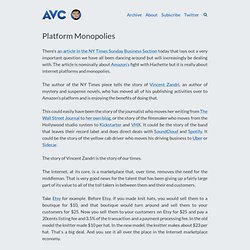
The article is nominally about Amazon’s fight with Hachette but it is really about internet platforms and monopolies. The author of the NY Times piece tells the story of Vincent Zandri, an author of mystery and suspense novels, who has moved all of his publishing activities over to Amazon’s platform and is enjoying the benefits of doing that.
This could easily have been the story of the journalist who moves her writing from The Wall Street Journal to her own blog, or the story of the filmmaker who moves from the Hollywood studio system to Kickstarter and VHX. The credentials trap. This is How Startups “Level Up” After Raising Money. One of the interesting things about being a VC is that you often see companies in transition.
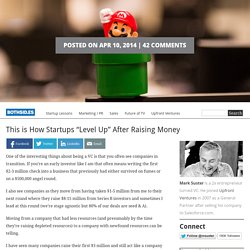
If you’re an early investor like I am that often means writing the first $2-3 million check into a business that previously had either survived on fumes or on a $500,000 angel round. I also see companies as they move from having taken $1-5 million from me to their next round where they raise $8-15 million from Series B investors and sometimes I lead at this round (we’re stage agnostic but 80% of our deals are seed & A). Moving from a company that had less resources (and presumably by the time they’re raising depleted resources) to a company with newfound resources can be telling. I have seen many companies raise their first $3 million and still act like a company that has no resources at all. And while this might sound to the inexperienced person like a sensible idea – it is not. Of course I’m not preaching crazy, irrational spend or having Kid Rock at your next company party. Level up. Nuts? Bubblicious? A (very) simple explanation of super high startup acquisition prices.
More often than not the reaction to a large company buying a comparatively small startup for a few hundred million or even a few billion is “nuts”, “bubblicious”, etc.
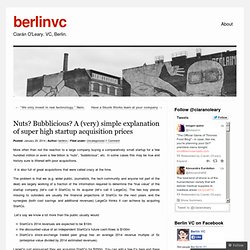
In some cases this may be true and history sure is littered with poor acquisitions.